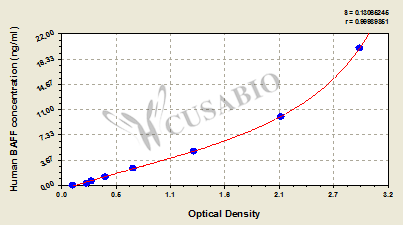CUSABIO's human BAFF ELISA kit is an in vitro enzyme-linked immunosorbent assay for quantitatively measuring human BAFF in serum, plasma, or tissue homogenates. This assay uses the sandwich enzyme immunoassay technique in combination with the enzyme-substrate chromogenic reaction to quantify the analyte in the sample. The color develops positively to the amount of BAFF in samples. The color intensity is measured at 450 nm via a microplate reader.
BAFF, encoded by the TNFSF13B gene, is a ligand for BAFFR that is required for peripheral B-cell survival and homeostasis. Upon binding to BAFFR, BAFF activates several downstream pathways that regulate basic survival functions including protein synthesis and energy metabolism necessary to extend the half-life of immature, transitional, and mature B cells. BAFF/BAFFR signaling plays a fundamental role during the transition from immature T1 to T2 B cells and therefore in the generation of mature B cells in the spleen. BAFF is increased in autoimmune diseases and is correlated with disease activity. increased levels of BAFF have been detected in the serum and synovial fluid of rheumatoid arthritis (RA) patients.






